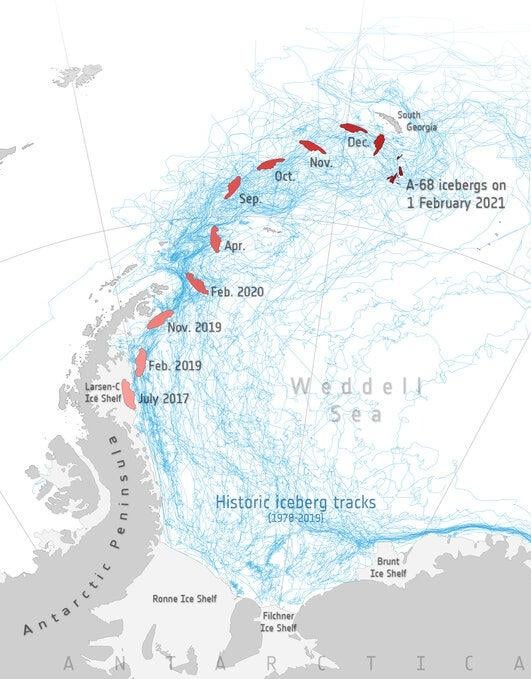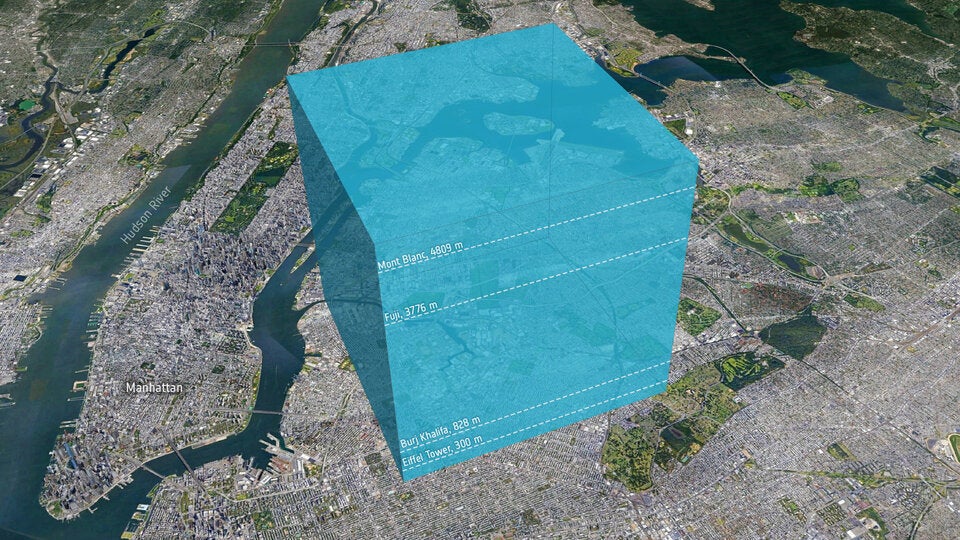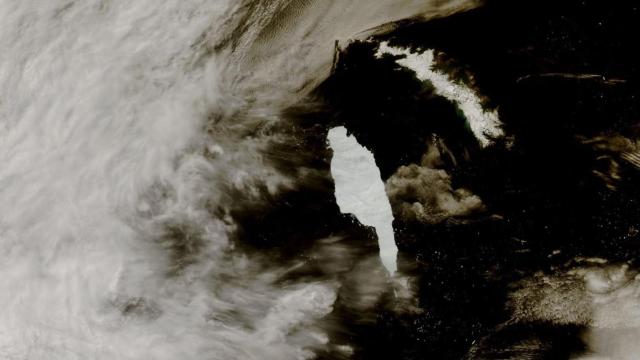Iceberg A-68a — the sixth largest in recorded history — released a hideous amount of freshwater near an ecologically sensitive island, according to new research chronicling the berg’s life.
Iceberg A-68a disintegrated in early 2021, but not before captivating the world with its eventful three-and-a-half year life. In a new paper published in Remote Sensing of Environment, researchers with the British Antarctic Survey and the Centre for Polar Observation and Modelling chronicle the ‘berg’s life using satellites.

Among the key findings was the rate at which the iceberg melted over time, the intense amount of freshwater spilled near the sub-Antarctic island of South Georgia, and how, thankfully, the iceberg failed to damage the seafloor along the island’s sensitive coast.
The iceberg split off from the Larsen C ice shelf in July 2017. At more than 5,180 square kilometres, the chunk of ice encompassed an area 1.6 times the size of Rhode Island. The ‘berg lost a chunk of itself almost immediately, resulting in its renaming to A68a and the naming of its offspring to A68b.
Iceberg A68a managed to rack up some serious mileage as it drifted some 4,000 kilometres northwards, and ominously, toward South Georgia island. Scientists feared that the iceberg — resembling a pointing finger — might damage the seafloor along the island’s coast, causing harm to the island’s abundant, but sensitive, wildlife.
Five different satellite missions were used to track A68a over time: Copernicus Sentinel-1, Copernicus Sentinel-3, Terra with its MODIS instrument, CryoSat, and ICESat-2. With these satellites, the team measured the thickness and area of the iceberg over the course of A68a’s entire life cycle. This took some extra work, however, as the gigantic ‘berg “had significant undulations in topography across its surface,” according to the paper.
As the scientists point out, A68a didn’t stray too far from its birthplace, and it didn’t melt very much, during the first two years of its life. The situation changed, however, as it moved northwards through the warmer waters of the Drake Passage.
“Frequent measurements allowed us to follow every move and break-up of the berg as it moved slowly northwards through an area called ‘iceberg alley,’ a route in the ocean which icebergs often follow, and into the Scotia Sea where it then gained speed and approached the island of South Georgia very closely,” Laura Gerrish, a mapping specialist at BAS and a co-author of the study, said in a press release.

From the time of its birth through to early 2021, A68a thinned from 235 metres thick to 168 metres, representing 32% of its total loss. The researchers confirmed in the study that the “distinct environmental conditions in the Weddell and Scotia Sea lead to rapidly increasing rates of melting and fragmentation once icebergs travel north of the Antarctic Peninsula.”
The iceberg had sufficiently melted such that, by the time it arrived at South Georgia, it was no longer deep enough to inflict extensive damage by scraping the seafloor. Ecologists were concerned at the time that if the ran aground near the island, it would prevent penguins from accessing their breeding grounds, block foraging marine animals, and disrupt ocean currents. Mercifully, A68a scraped the seafloor only very briefly; the bottom, or keel, of the iceberg reached 141 metres beneath the surface, whereas the main seabed is 150 metres below the surface. What’s more, the iceberg broke up shortly after arriving at South Georgia, greatly reducing any blocking effects.

That said, iceberg A68a released 168 billion tons of freshwater filled with nutrients in the immediate vicinity of South Georgia. That’s akin to 61 million Olympic-sized swimming pools. Simply put that’s… a lot of water. This is certain to have an effect on the local ecology, as a statement from ESA points out:
When icebergs detach from ice shelves, they drift with the ocean currents and wind, releasing cold fresh meltwater and nutrients as they melt. This process influences the local ocean circulation and fosters biological production around the iceberg.
As to the potential positive and negative effects of this process, the researchers can only guess, writing that “[m]ore research should be conducted to study the impact of this alteration on the marine life around South Georgia.”
The new paper will likely be helpful to scientists who study the movements of icebergs in this area. “As this is a common iceberg trajectory, our results could also help to predict the disintegration of other large … icebergs and to include their impact in ocean models,” the scientists wrote.
